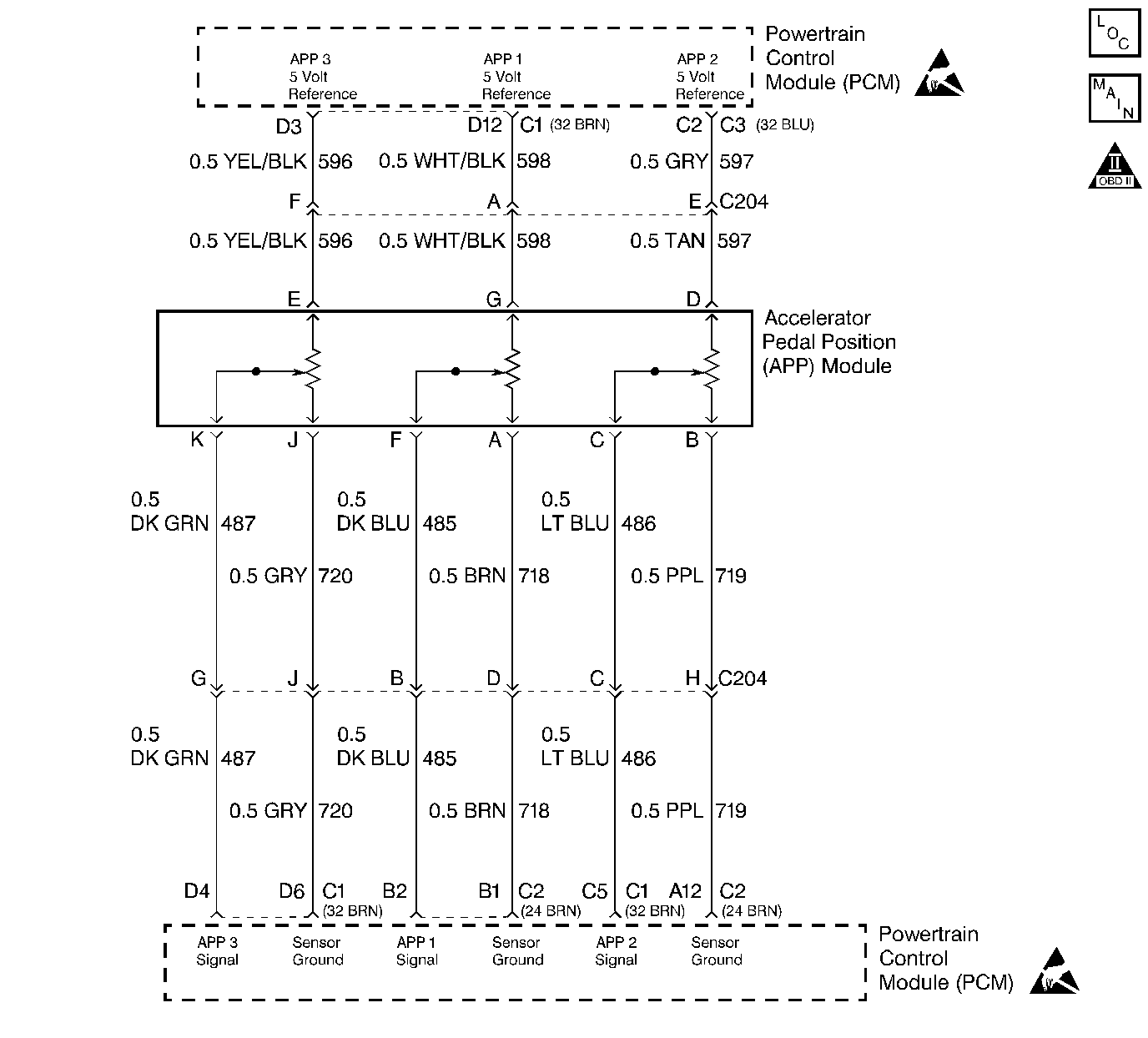
Circuit Description
The Accelerator Pedal Position (APP) module provides a voltage signal that changes relative to accelerator pedal position. There are three sensors located within the APP module that are scaled differently. This is a type D DTC.
Conditions for Setting the DTC
| • | Ignition voltage greater than 6.4 volts. |
| • | Engine speed greater than 300 RPM. |
| • | The difference between APP 1 and APP 2 is greater than .23 volts (PCM compares pre-scaled voltage (internal to PCM)). |
| • | The difference between APP 1 and APP 3 is greater than .50 volts (PCM compares pre-scaled voltage (internal to PCM)). |
| • | No in range faults for APP 2 or APP 3 (PCM checks for high and low voltage faults). |
| • | Conditions met for 2 seconds. |
Action Taken When the DTC Sets
| • | The input from APP 1 sensor is ignored. |
| • | A current and history DTC will set but it will not turn on the Service Throttle Soon lamp. |
| • | Throttle will operate normally as long as there is only one malfunction present. If there are two APP malfunctions present, the PCM will turn ON the Service Throttle Soon lamp and limit power. If a third APP malfunction is present, the Service Throttle Soon lamp will be ON and only allow the engine to operate at idle. |
Conditions for Clearing the MIL/DTC
| • | A History DTC will clear when forty consecutive warm-up cycles that the diagnostic does not fail (coolant temperature has risen 5°C (40°F) from start up coolant temperature and engine coolant temperature exceeds 71°C (160°F) that same ignition cycle. |
| • | Use of a Scan tool |
Diagnostic Aids
A scan tool reads APP 1 position in volts. It should read about .45 to .95 volt with throttle closed and ignition ON or at idle. Voltage should increase at a steady rate as throttle is moved toward Wide Open Throttle (WOT).Also, 90% pedal travel is acceptable for correct APP operation. Scan APP 1 sensor while depressing accelerator pedal with engine stopped and ignition ON. Display should vary from about .74 volt when throttle was closed to over about 3.7 volts when throttle is held at Wide Open Throttle (WOT) position. The following chart will check voltages on all APP circuits to see if they fall in normal ranges. The PCM compares pre-scaled voltages (these are voltages that the scan tool can't read). The scan tool reads only output voltages.
Test Description
Number(s) below refer to the Step number(s) on the Diagnostic Table.
-
This Step determines if there is a good 5 volt reference.
-
This Step will check for an open in the ground circuit.
Step | Action | Value(s) | Yes | No |
|---|---|---|---|---|
1 |
Important: Before clearing DTCs use the scan tool Capture Info to record freeze frame and failure records for reference, as data will be lost when Clear Info function is used. Was the On-Board Diagnostic (OBD) System Check performed? | -- | ||
2 |
Are APP voltages at specified values? | .45-.95 V 4.0-4.5 V 3.6-4.1 V | ||
3 | DTC is intermittent. If no additional DTCs are stored, refer to Diagnostic Aids. If additional DTCs were stored, refer to the applicable DTC table(s) first. Are additional DTCs stored? | -- | Go to the Applicable DTC Table | Go to Diagnostic Aids |
Is voltage at the specified value on all circuits? | 4.75 V | |||
Is Test light ON (all circuits)? | -- | |||
6 |
Was the 5 volt reference circuit open or shorted to ground? | -- | ||
7 | Check the 5 volt reference circuit for a poor connection at the PCM and replace terminal if necessary. Did the terminal require replacement? | -- | ||
8 |
Was APP sensor ground circuit open? | -- | ||
9 | Replace the APP module. Refer to Accelerator Pedal Position Module Replacement Is the action complete? | -- | -- | |
10 | Replace the faulty PCM. Important: If the PCM is faulty, the new PCM must be programmed. Refer to Powertrain Control Module Replacement/Programming Is the action complete? | -- | -- | |
11 |
Does the Scan Tool indicate that this diagnostic Ran and Passed? | -- | ||
12 | Using the Scan Tool, select Capture Info, Review Info. Are any DTCs displayed that have not been diagnosed? | -- | Go to the Applicable DTC Table | System OK |
